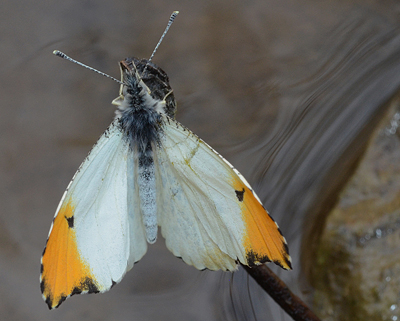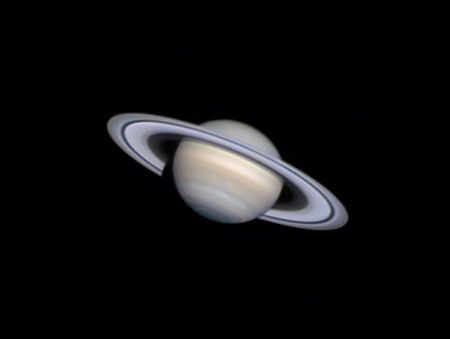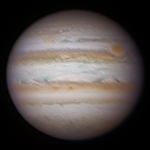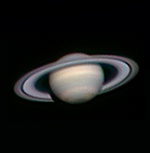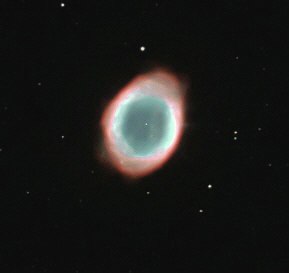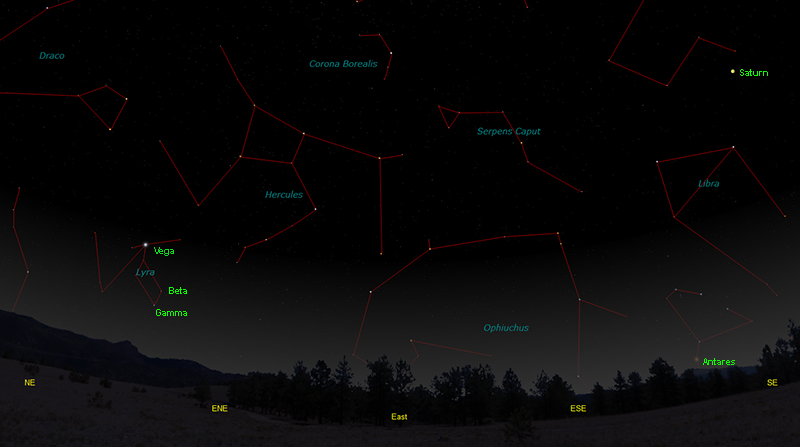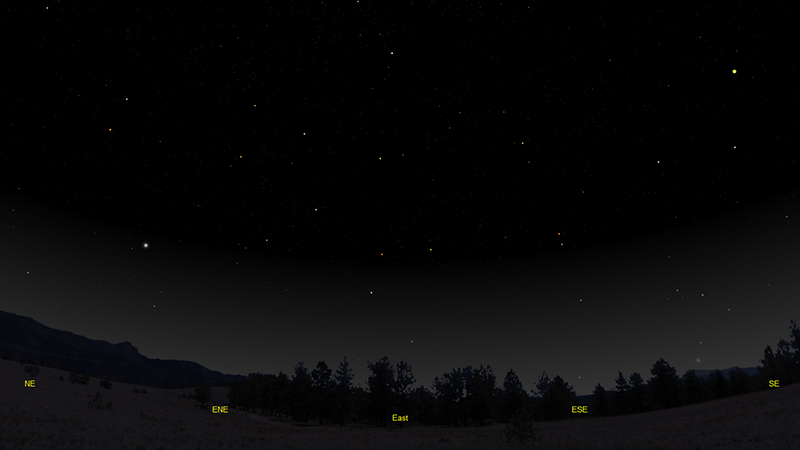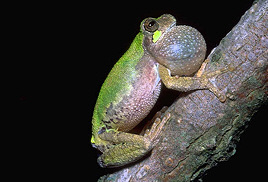The purpose of this feature is to give scout leaders, educators and naturalists an idea of some of the natural events coming up each month. We will try to cover a variety of natural events ranging from sky events to calling periods of amphibians, bird and mammal watching tips, prominent wildflowers and anything else that comes to mind. We will also note prominent constellations appearing over the eastern horizon at mid-evening each month for our area for those who would like to learn the constellations. If you have suggestions for other types of natural information you would like to see added to this calendar, let us know! Note: You can click on the hyperlinks to learn more about some of the featured items. To return to the Calendar, hit the "back" button on your browser, NOT the "back" button on the web page. All charts are available in a "printer friendly" mode, with black stars on a white background. Left clicking on each chart will take you to a printable black and white image. Please note that images on these pages are meant to be displayed at 100%. If your browser zooms into a higher magnification than that, the images may lose quality. Though we link book references to nationwide sources, we encourage you to support your local book store whenever possible. Notes and Images From April 2013
On April 6th we participated in a bioblitz at Wells Creek Park near Fayetteville, Tennessee. The blitz was organized by the Tennessee Native Plant Society and we were there mainly to help out on amphibians. We spent a pleasant morning and afternoon walking the area, which has several waterfalls. We found a Spring Salamander in Wells Creek. This appears to be a new county record for Lincoln County. The wildflowers were abundant, and we were fortunate to be in the company of some experts in that field. We learned a lot.
The butterflies were also interesting. We saw our first Tiger Swallowtail of the season, and Falcate Orangetips were everywhere. I photographed this one on a small twig over the creek. This butterfly is in the family Pieridae, which includes the whites and sulphurs. They are a spring butterfly, and feed on the nectar of violets and mustards. The future of this property is uncertain. We can only hope whoever ends up acquiring the property treats it gently.
On April 20th we participated in another bioblitz at Beaman Park, northwest of Nashville. It was a beautiful spring morning, perfect for hiking. We photographed this spider on the forest floor. According to my friend Steve Murphree, who managed to catch this spider, it appears to be a type of purse web spider in the genus Sphodros. It is perhaps Sphodros niger. It is a testament to my faith in Steve's extraordinary identification skills that I let this little spider crawl all over my hand as we were positioning it for an image. This spider is a mygalomorph, placing it in the same group as tarantulas, trap door spiders and funnel web spiders. The web forms a tube, which in part lines the burrow. The spider waits for prey to get caught in the web, then uses its large, forward-facing chelicerae to seize the unlucky victim. The prey is then dragged into the burrow and eaten. Sometimes it's good not to be at the small end of the food chain.
We were both pleased and honored to have our February 7th, 2012 image of Saturn used in both the May, 2012 and May, 2013 issues of Sky and Telescope. The credit really goes to some very steady atmospheric conditions on the morning we took the image. The image is also used in this week's Sky and Telescope Bulletin, and in a new app for i-phones and i-pads called SaturnMoons. The following is from my notes for that night: "The world seems peaceful in the early morning hours. Two Great Horned Owls called softly back and forth from the tree line that borders our field. Upland Chorus Frogs called very slowly from our pond. A Birmingham-bound freight train passed. A chorus of coyotes began calling, their high calls and yipping notes coming from across the tracks, though they seemed very close. The woodcocks continued to call, and every now and then I'd hear the soft twittering notes that they make as they dive and swoop back to the ground after their long spiraling climb. I continued to video Saturn till around 5:00am. It was then about 27 degrees Fahrenheit, and I was starting to feel a little tired and cold. Frost covered the scope and the keyboard of my computer. I turned off the drive of the scope, lugged the computer hardware back inside, and then fell into bed." Sky Events for May 2013: The Eta Aquariid Meteor Shower peaks on the morning of May 5th. The radiant for this shower is fairly low in the sky for Northern Hemisphere observers. Evening Sky:
Jupiter is about 15 degrees above the western horizon in the early evening on the first of the month. Binoculars, if held steady, will show the four Galilean moons when they are not transiting the planet or being eclipsed. The great planet will sink into the twilight by the end of the month, but not before putting on great show with Mercury and Venus. On the evening of May 24th, the three planets are all within a 5 degree circle. Try viewing them about 45 minutes after sunset. This is a great opportunity to see the relative movement of the planets from one day to the next.
Saturn is about 20 degrees above the southeastern horizon in the early evening, in Libra. The rings are open to around 19 degrees, giving a beautiful view of the very dark Cassini's Division. To get the best telescopic views wait till the planet has climbed high above the southern horizon. On May 1st Saturn transits around 12:30am. This is a great time to be viewing Saturn. Just about any telescope will give a remarkable view. Galileo, whose discovery of the moons of Jupiter brought him both fame and heartache, would have given anything to have the view of Saturn through even a modern 2 inch aperture telescope. His telescope lacked sufficient resolution to enable him to resolve the ring, and the planet's true nature remained a mystery to him. The Moon should be very slender crescent on the evenings of May 10th, 11th and 12th. On the 10th, look for it about 30 minutes after sunset low in the West-Northwest, just to the left of and slightly below Venus. Look for it below Jupiter on the 11th, and above and to the left of Jupiter on May 12th. All times noted in the Sky Events are for Franklin, Tennessee and are Central Daylight Time.
Constellations: The views below show the sky looking east at 9:30pm CDT on May 15th. The first view shows the sky with the constellation outlined and names depicted. Star and planet names are in green. Constellation names are in blue. The second view shows the same scene without labels. New constellations this month in the eastern sky are Lyra, the Lyre, with it's bright star Vega, Serpens Caput, the head of the Serpent, and Libra, the Scales. The red giant Antares (the name means Rival of Mars) is just making its way over the eastern horizon in Scorpius. Ophiuchus, the Serpent Bearer, is also climbing into view. Wait until Lyra is high in the sky, and then see if you can spot Messier 57, the Ring Nebula. Look for it a little over half the way from Gamma Lyra to Beta Lyra. A three inch aperture telescope will show this planetary nebula, which looks like a ghostly smoke ring. For more on the nebula, see here.
On Learning the Constellations: We advise learning a few constellations each month, and then following them through the seasons. Once you associate a particular constellation coming over the eastern horizon at a certain time of year, you may start thinking about it like an old friend, looking forward to its arrival each season. The stars in the evening scene above, for instance, will always be in the same place relative to the horizon at the same time and date each May. Of course, the planets do move slowly through the constellations, but with practice you will learn to identify them from their appearance. In particular, learn the brightest stars (Like Vega and Antares in the above scene looking east), for they will guide you to the fainter stars. Once you can locate the more prominent constellations, you can "branch out" to other constellations around them. It may take you a little while to get a sense of scale, to translate what you see on the computer screen or what you see on the page of a book to what you see in the sky. Look for patterns, like the stars that make up the constellation Hercules. The earth's rotation causes the constellations to appear to move across the sky just as the sun and the moon appear to do. If you go outside earlier than the time shown on the charts, the constellations will be lower to the eastern horizon. If you observe later, they will have climbed higher. As each season progresses, the earth's motion around the sun causes the constellations to appear a little farther towards the west each night for any given time of night. If you want to see where the constellations in the above figures will be on June 15th at 9:30pm CDT, you can stay up till 11:30pm CDT on May 15th and get a preview. The westward motion of the constellations is equivalent to two hours per month. Recommended: Sky & Telescope's Pocket Star Atlas is beautiful, compact star atlas. A good book to learn the constellations is Patterns in the Sky, by Hewitt-White. You may also want to check out at H. A. Rey's classic, The Stars, A New Way to See Them. For skywatching tips, an inexpensive good guide is Secrets of Stargazing, by Becky Ramotowski. A good general reference book on astronomy is the Peterson
Field Guide,
A Field Guide to the Stars and Planets, by Pasachoff. The book retails for around $14.00. Starry Night has several software programs for learning the night sky. Visit the Starry Night web site at www.starrynight.com for details. The Virtual Moon Atlas is a terrific way to learn the surface features of the Moon. And it's free software. You can download the Virtual Moon Atlas here. Cartes du Ciel (described in the monthly notes above) is a great program for finding your way around the sky. It is also free, and can be downloaded here. Apps: We really love the Sky Safari 3 Pro application described here. For upcoming events, the Sky Week application is quite nice. Both apps are available for both I-phone and Android operating systems. Amphibians:
By the end of May all of Tennessee's frogs and toads are either calling or have already reached their peak calling period and are being heard less. The treefrogs are the last of our frogs and toads to start calling. Cope's Gray Treefrog and Gray Treefrogs start giving isolated calls as early as late February, and by the end of this month listen also for Bird-Voiced Treefrogs, Green Treefrogs and Barking Treefrogs. In May we also hear Fowler's Toads calling frequently, so listen for their "crying baby" call. Northern Cricket Frogs are hitting their stride as well. Listen for a sound like two stones being tapped together. We have heard eight or more species of frogs calling on some May evenings, so it's a great time to listen. Upland Chorus Frogs and Spring Peepers continue to call. Listen for their calls to increase in pitch and quicken with the rising temperatures. Recommended: The Frogs and Toads of North America, Lang Elliott, Houghton Mifflin Co. Archives (Remember to use the back button on your browser, NOT the back button on the web page!) Natural Calendar February 2013 Natural Calendar December 2012 Natural Calendar November 2012 Natural Calendar September 2012 Natural Calendar February 2012 Natural Calendar December 2011 Natural Calendar November 2011 Natural Calendar September 2011 Natural Calendar February 2011 Natural Calendar December 2010 Natural Calendar November 2010 Natural Calendar September 2010 Natural Calendar February 2010 Natural Calendar December 2009 Natural Calendar November 2009 Natural Calendar September 2009 Natural Calendar February 2009 Natural Calendar December 2008 Natural Calendar November 2008 Natural Calendar September 2008 Natural Calendar February 2008 Natural Calendar December 2007 Natural Calendar November 2007 Natural Calendar September 2007 Natural Calendar February 2007 Natural Calendar December 2006 Natural Calendar November 2006 Natural Calendar September 2006 Natural Calendar February 2006
Natural Calendar December 2005
Natural Calendar November 2005
Natural Calendar September 2005
Natural Calendar February 2005
Natural Calendar December 2004
Natural Calendar November 2004
Natural Calendar September 2004
Natural Calendar February 2004
Natural Calendar December 2003
Natural Calendar November 2003
Natural Calendar September 2003 Natural Calendar February 2003 Natural Calendar December 2002 Natural Calendar November 2002 Nature Notes Archives: Nature Notes was a page we published in 2001 and 2002 containing our observations about everything from the northern lights display of November 2001 to frog and salamander egg masses. Night scenes prepared with The Sky Professional from Software Bisque All images and recordings © 2013 Leaps |
|||||||||||||||||

